Topics
Category
Era
Scotch Tape
When 3M began doing business in 1902, it made sandpaper. Soon the sandpaper company invented a line of products that changed household life around the world. 3M's Scotch-brand masking tape and cellophane tape were small inventions that started a consumer revolution.
Minnesota Mining and Manufacturing (3M) was founded in Two Harbors in 1902. By 1920 the company had developed some of the best sandpapers in the world. When it put out a call for new engineers to join the company, Richard Drew wrote to ask for the job. Drew, then an engineering student, had been putting himself through school by playing the banjo in several Twin Cities dance bands. He was hired to take trial samples of 3M products to auto shops, which used the sandpaper to prepare cars for painting. While on a delivery in 1923, he noticed that the auto shops had a problem.
At the time, two-tone paint jobs were very popular. At the auto shops, Drew watched painters struggle to seal off areas for the two-color painting process. The tape that painters used either didn't seal effectively or stuck so tightly that it peeled the paint. The tapes left gummy residue that ruined the car's finish. After seeing the problem, Drew had the idea to create a new tape.
After presenting the idea to his supervisors, Drew was granted the use of a laboratory, where he experimented with different adhesives and backings. He eventually found an adhesive that sealed tightly while releasing cleanly. He applied it to a crepe paper backing, which gave the tape the ability to stretch and adapt to curves and contours. In 1925, 3M released Drew's invention: the Scotch-brand masking tape.
While there is some uncertainty about why the line of tape was dubbed Scotch, company legend says that the name came about during the tape's testing phase. Scotch was a pejorative meaning cheap or stingy. In early versions of the tape, some say, Drew applied only minimal adhesive to avoid over sticking. It's said that while using this insufficiently sticky tape, a frustrated auto painter said: "Why so Scotch with the adhesive?" The story goes that Drew took the hint and added more adhesive until both the tape and the name stuck.
After he created masking tape, Drew began to experiment with adhesives to create another kind of pressure-sensitive tape. Cellophane was frequently used to wrap products in bakeries and grocery stores, but it could not seal the packages. Drew thought that he could use the cellophane itself, coated with an adhesive, to provide a good seal. His experiments led to the 1930 release of Scotch-brand cellulose tape. Although DuPont invented a way to heat seal cellophane packages shortly thereafter, making the tape redundant, Scotch Tape had already found a niche in the American home.
Even though Depression-era Americans had less disposable income than usual, Scotch Tape became a necessity for the times. People discovered that the tape could mend items and make them last longer. Scotch Tape could repair items almost invisibly, giving household goods longer lives at a time when replacing them was out of the question. By 1939, 3M had started marketing Scotch Tape in the familiar snail-shaped package to allow for easy tape dispensing.
Over the decades, Drew and other 3M inventors developed a wide range of other tapes. In 1945, Scotch-brand tapes introduced a tartan design and in the 1950s, mascot Scotty McTape appeared in print and television advertising. In 1961, 3M released Scotch-brand Magic Tape. The new tape was frosty on the roll, but it nearly disappeared when applied. Magic tape had a matte surface that could be written on, unlike previous transparent tapes, and it resisted yellowing with age.
When American consumers were polled in 1985, they voted Scotch Tape the most indispensable household product. In the early twenty-first century the company produced 5.5 million miles of tape every year, or 645 miles of tape per hour. Originally a product to help auto painters, Richard Drew's invention of Scotch Tape offered a sticky solution to the world.
Bibliography
Huck, Virginia. Brand of the Tartan: The 3M Story. New York: Appleton-Century-Crofts, Inc., 1955.
Nord, Mary Ann. "Bright Ideas." Roots 10, no. 2 (Winter 1982): 8–11.
Scotchbrand. FAQ.
http://www.scotchbrand.com/3M/en_US/scotch-brand/faqs/
Scotchbrand. Timeline.
http://www.scotchbrand.com/3M/en_US/scotch-brand/about/
Related Resources
Primary
Richard G. Drew Papers, 1921–1987
Manuscript Collection, Minnesota Historical Society, St. Paul
Description: Papers, newspaper clippings, and photographs detailing Richard Drew's work with Minnesota Mining and Manufacturing.
3M Historical Corporate Records, 1892–2006
Manuscript Collection, Minnesota Historical Society, St. Paul
http://www2.mnhs.org/library/findaids/00281.xml
Description: Collection of product advertising and production materials, including Scotch Tape. Also contains company history documents and files.
Secondary
100: A Century of Innovation. St. Paul: 3M Company, 2002.
MacKay, Neil. A Chemical History of 3M. Minneapolis: 3M Chemical, Film & Allied Products Group, 1991.
I'll Buy That! The 50 Small Wonders and Big Deals that Revolutionized the Lives of Consumers. Mount Vernon, NY: Consumer Reports Books, 1986.
Our Story So Far: Notes from the first 75 years of the 3M Company. St. Paul: Minnesota Mining and Manufacturing Company, 1977.
Web
National Inventors Hall of Fame. Richard G. Drew Profile.
http://invent.org/inductee-detail/?IID=329
Related Images
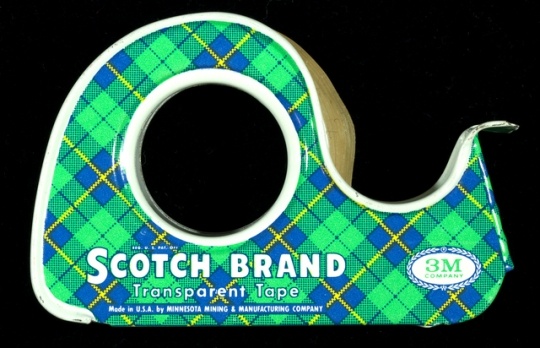
Scotch-brand transparent tape
Roll of 3M Scotch-brand transparent tape, c.1960.
All rights reserved
Holding Location
Articles
More Information
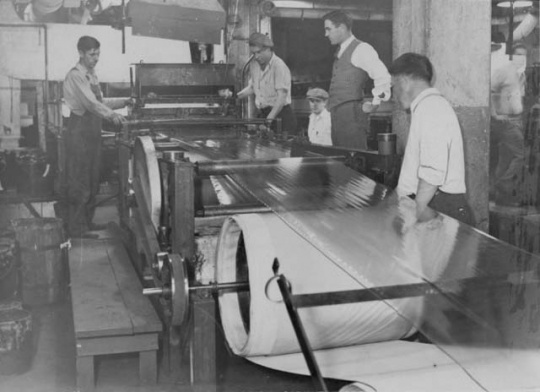
Manufacture of cellulose tape, Minnesota Mining and Manufacturing Company, St. Paul
Factory production of cellulose tape, 1931.
Holding Location
Articles
More Information
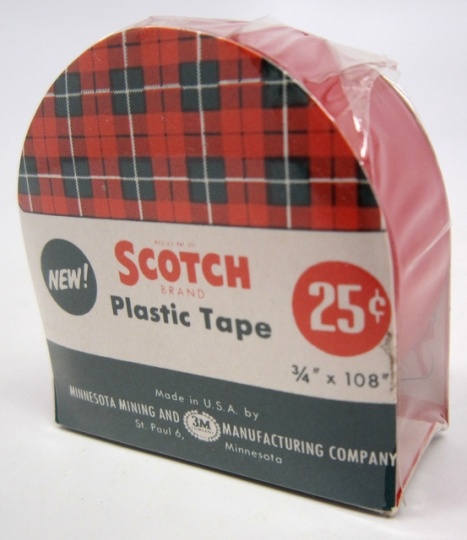
3M plastic household tape
Cellophane-wrapped paper package containing red 'SCOTCH/BRAND/Plastic Tape', by Minnesota Mining and Manufacturing Company, St. Paul, Minnesota, 1943–1963.
All rights reserved
Holding Location
Articles
More Information
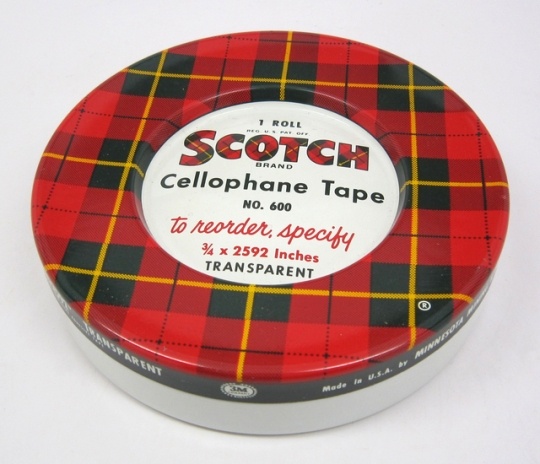
Scotch-tape container
Round steel container with red plaid decoration on removable lid for '1 ROLL/...SCOTCH/BRAND/Cellophane Tape/...', made by Minnesota Mining and Manufacturing Company, St. Paul, Minnesota,1953–1963.
All rights reserved
Holding Location
Articles
More Information
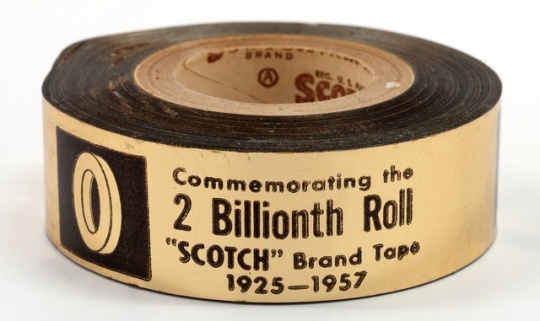
Commemorative two billionth roll of Scotch-brand tape
Roll of 3M Scotch-brand tape made to commemorate the production of the two billionth roll of that product, 1957.
All rights reserved
Holding Location
Articles
More Information
Related Articles
Turning Point
In 1925, 3M releases its Scotch brand of masking tape, the first product in the line of Scotch-brand tapes that would make the company famous.
Chronology
1925
1930
1939
1945
1961
Bibliography
Huck, Virginia. Brand of the Tartan: The 3M Story. New York: Appleton-Century-Crofts, Inc., 1955.
Nord, Mary Ann. "Bright Ideas." Roots 10, no. 2 (Winter 1982): 8–11.
Scotchbrand. FAQ.
http://www.scotchbrand.com/3M/en_US/scotch-brand/faqs/
Scotchbrand. Timeline.
http://www.scotchbrand.com/3M/en_US/scotch-brand/about/
Related Resources
Primary
Richard G. Drew Papers, 1921–1987
Manuscript Collection, Minnesota Historical Society, St. Paul
Description: Papers, newspaper clippings, and photographs detailing Richard Drew's work with Minnesota Mining and Manufacturing.
3M Historical Corporate Records, 1892–2006
Manuscript Collection, Minnesota Historical Society, St. Paul
http://www2.mnhs.org/library/findaids/00281.xml
Description: Collection of product advertising and production materials, including Scotch Tape. Also contains company history documents and files.
Secondary
100: A Century of Innovation. St. Paul: 3M Company, 2002.
MacKay, Neil. A Chemical History of 3M. Minneapolis: 3M Chemical, Film & Allied Products Group, 1991.
I'll Buy That! The 50 Small Wonders and Big Deals that Revolutionized the Lives of Consumers. Mount Vernon, NY: Consumer Reports Books, 1986.
Our Story So Far: Notes from the first 75 years of the 3M Company. St. Paul: Minnesota Mining and Manufacturing Company, 1977.
Web
National Inventors Hall of Fame. Richard G. Drew Profile.
http://invent.org/inductee-detail/?IID=329






